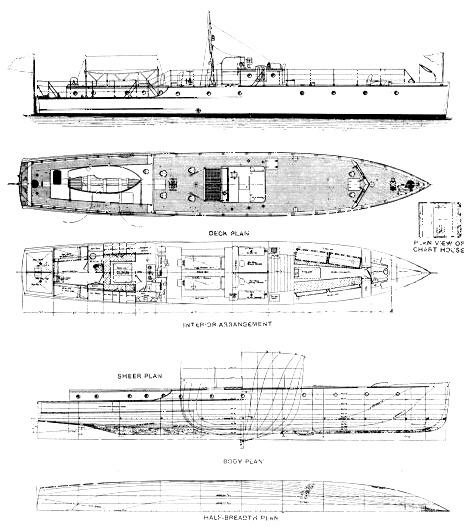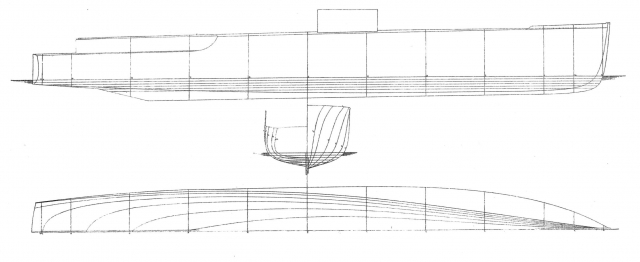A Lines Drawing
Lines drawings of the ML are relatively scarce - having appeared in only two or three known publications. For the most part, these drawings are of the "study plan" sort rather than being actual construction plans (if you've got copies I'd love to see them!).
One drawing appeared in the November, 1921 issue of The Yachting Monthly with the caption "As far as we are aware, the lines of an M.L. have never been reproduced before, but we have so often criticised the construction of these boats, that we make no comment on the present occasion. One thing will be immediately apparent to all: the M.L. is a smooth-water boat."
Lines drawings of the ML are relatively scarce - having appeared in only two or three known publications. For the most part, these drawings are of the "study plan" sort rather than being actual construction plans (if you've got copies I'd love to see them!).
One drawing appeared in the November, 1921 issue of The Yachting Monthly with the caption "As far as we are aware, the lines of an M.L. have never been reproduced before, but we have so often criticised the construction of these boats, that we make no comment on the present occasion. One thing will be immediately apparent to all: the M.L. is a smooth-water boat."
In the next, December, issue of the magazine, a former RNVR officer wrote in defence of the ML:
In Defence of M.L.'s
Sir, In the November issue of your excellent magazine the lines of an M.L. are reproduced together with some remarks - presumably Editorial - at the foot of the drawings.
May I be permitted to say that the statement that is made in the last sentence conveys an utterly wrong impression, inasmuch as an M.L. is only a smooth-water boat to this extent - that she is decidedly most comfortable under such weather conditions. The Official Specification refers to M.L.'s as 80-ft. lifeboats, and I recall the amusement with which we R.N.V.R. officers read that at the time we first became acquainted with them: long experience of them under the worst possible weather conditions compel me to admit that such a description is nothing more than the absolute truth.
Speaking entirely for myself, and without seeing the lines at all, I came to the same conclusion as your commentator, and I still think that, theoretically, the design forces one to the belief; but facts are stubborn things and one cannot get away from them: if anyone still retains the impession that an M.L. is only a fine-weather and smooth-water craft, and is sufficiently interested to give me a call, I will show him log entries of some passages that I have made in an M.L. and undertake to convince him that in a thoroughly bad sea he would probably fare better in an M.L. than, say, a North Sea trawler. I know that is a bold statement to make, but it is warranted.
E.A. Pearce,
Lieut.-Commr. R.N.V.R.
Sir, In the November issue of your excellent magazine the lines of an M.L. are reproduced together with some remarks - presumably Editorial - at the foot of the drawings.
May I be permitted to say that the statement that is made in the last sentence conveys an utterly wrong impression, inasmuch as an M.L. is only a smooth-water boat to this extent - that she is decidedly most comfortable under such weather conditions. The Official Specification refers to M.L.'s as 80-ft. lifeboats, and I recall the amusement with which we R.N.V.R. officers read that at the time we first became acquainted with them: long experience of them under the worst possible weather conditions compel me to admit that such a description is nothing more than the absolute truth.
Speaking entirely for myself, and without seeing the lines at all, I came to the same conclusion as your commentator, and I still think that, theoretically, the design forces one to the belief; but facts are stubborn things and one cannot get away from them: if anyone still retains the impession that an M.L. is only a fine-weather and smooth-water craft, and is sufficiently interested to give me a call, I will show him log entries of some passages that I have made in an M.L. and undertake to convince him that in a thoroughly bad sea he would probably fare better in an M.L. than, say, a North Sea trawler. I know that is a bold statement to make, but it is warranted.
E.A. Pearce,
Lieut.-Commr. R.N.V.R.
The Yachting Monthly, December, 1921
Contrary to the magazine's impression, ML plans had indeed been published elsewhere the year before in William Nutting's The Cinderellas of the Fleet. Again, more a study plan than anything else. But this time a bit more detailed, and perhaps from the same source as the later images presented by The Yachting Monthly.

The design of the British ML
The Cinderellas of the Fleet
